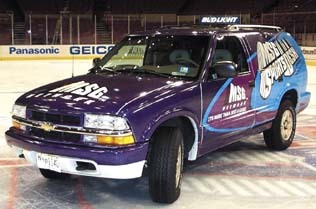Vehicles + Vinyl
The Right Vinyl for You
Cast and calendered vinyls contrasted
Published
18 years agoon

I’ve never been a fan of calendered films. When I entered the industry, cast vinyl ruled the marketplace. Calendered film had a bad reputation — with good reason. These films shrunk so noticeably they left a telltale adhesive residue around an emblem — a "ring around the collar."
As older versions of calendered vinyls aged, they became brittle and cracked. Pigmented films didn’t withstand the rigors of exterior exposure. They faded, chalked or changed colors.
In the past, one manufacturer’s tomato-red, calendered film frequently turned dark burgundy when used outdoors. Previously, the stiff, non-conformable calendered films were much thicker. In addition to rigidity and color fading, your father’s calendered films were prone to shrinkage.
However, calendered films have changed with the times. Today, they’re thinner and more flexible. Some of the newer, glossier, calendered vinyls appear nearly identical to cast films. Plus, current calendered films shrink less and cause fewer edge-lifting problems.
Improved resins, plasticizers, pigments and additives have also improved calendered films’ weatherability. All these improvements spur many signshops to use more calendered vinyl than cast.
However, appearances can be deceiving. While calendered films have evolved, some performance characteristics haven’t improved. That’s important to remember when your name’s on the sign and your reputation’s on the line.
AdvertisementBy comparing the two major classifications of flexible, signmaking vinyls — cast and calendered — this article will explain how vinyl films are made, outline their characteristics and offer suggestions to help you determine the right film for the situation.
Roll the film
Pressure-sensitive films typically comprise facestock, adhesive and liner paper. Polyvinyl chloride (PVC) films comprise the majority of sign materials. Polyesters, foils and reflective films are also used for sign applications, but to a much lesser extent.
PVC films include both cast and calendered materials. Because manufacturers employ different processes and raw materials to produce these films, they exhibit unique physical properties and performance characteristics.
Calendered films (which some in the sign trade still call "4-mil" vinyl) are available in various gauges. However, today, it’s doubtful that any are actually 4 mils thick. As technology improved, films got thinner.
Raw materials for calendered films — PVC resins, pigments and plasticizers — are usually solid, but may also include some liquid ingredients. After being measured and fed into a mixer, the materials are blended to ensure the finished product’s color consistency and uniformity. These materials are then heated and rolled into a continuous film sheet.
AdvertisementThe finish on the roller’s surface determines the finish on the film’s surface. A highly polished roller finish, for example, imparts a high gloss. The calendering process is like rolling out pie dough with a rolling pin. This stretching process builds mechanical stress into the film. Just as dough shrinks after rolling, calendered vinyl contracts immediately.
For some applications, calendered vinyls are a suitable, cost-effective alternative to cast vinyls. Cheaper raw materials, such as lower-grade pigments and plasticizers, mean lower cost. However, they may compromise performance.
Plasticizing oils that comprise calendered film are much more volatile than those used in cast vinyl. When subjected to UV light, heat, chemical spillage and pollution, less-stable plasticizers can leech out of a calendered vinyl and migrate into the film’s surface or adhesive.
Loss of oil causes vinyl to lose flexibility. When this happens, brittleness and cracking usually occur. Plasticizer migration into the film’s adhesive can soften it and destroy its adhesive bond, resulting in either adhesive failure or graphic shrinkage.
When dealing with large quantities, the calendering process outperforms casting. A high-speed, high-output manufacturing process, calendering produces large volumes at a relatively low cost. A typical production run can produce up to 225,000 sq. ft. Because mass production increases inventory investment, vinyl manufacturers limit the color range of calendered vinyls. With such high production requirements, custom colors are often unfeasible.
Calendered films possess other advantages. Excellent tensile strength enables calendered film to pull itself through the extrusion process. Thus, it’s less likely to tear than cast film, and it can withstand greater impact and abrasion. This is why thicker calendered films are sometimes used as gas-pump skirts. Their stiffness and strength also facilitate application and film removal.
AdvertisementCalendered films’ dimensional stability, flexibility, caliper control and durability have improved, but they still shrink. Regardless of film thickness or the degree of applied heat and effort, calendered films tent around rivets and lift in corrugation valleys over time.
Honey, I shrunk the vinyl!
I formerly thought all calendered vinyls were created equal. Boy, was I wrong! While working for a screenprinter, I’d been using a high-end calendered film that was nearly as costly as cast films to decorate building and canopy fascias for gas stations and convenience stores. The manufacturer also marketed another calendered vinyl that cost approximately half the price of our standard material. I thought the two products couldn’t be that different.
I decided to experiment with the cheaper film for a multi-color, truck-door decal. We printed one color, letting the ink air-dry overnight. The next day, we discovered the vinyl shrunk 1/4 in. away from the liner all the way around the decal. As a result, the second color was impossible to register.
We scrapped my little experiment and started from scratch. This taught me the difference between monomeric and polymeric films.
Polymeric films comprise more complex building blocks with a higher molecular weight than simpler, cheaper monomeric films. The complex structure stabilizes polymeric films and contributes to increased durability.
Liquid origins
Cast films — typically called "high-performance" or "2-mil" vinyls — comprise liquid materials, rather than solids. The liquid, which resembles paint, is called an organosol. Similar to calendered films, cast materials contain pigments, plasticizers, PVC resins, solvents and additives.
However, cast-vinyl manufacturers use more costly, automotive-grade pigments and heavy, stable plasticizing oil. The film retains the weightier oil throughout its life, which keeps the film flexible. By comparison, calendered film’s lighter, more volatile oil helps lubricate extrusion rollers during the manufacturing process. However, eventually, the lighter oil leeches out and leaves the film brittle.
When manufacturing cast films, liquid organosol is coated or poured onto the casting paper. As the paper travels through a 75-ft. oven, the organosol is baked at 400 to 450°F.
Baking evaporates solvents from the wet organosol, leaving a dry film. In this "fusion" process, the plasticizer bonds with the PVC resin, giving cast-vinyl film its strength.
This fusion is the key to making film, because it affects virtually all its properties, such as elongation; modulus (measurement of the stress a material can absorb before losing its elasticity); adhesive anchorage to the facestock; ink adhesion; system durability; shrinkage; and the film’s hue and gloss.
The bond’s quality depends on the molecular weight of the plasticizers, PVC resin, pigment and additives; the type of solvent used; and the length of the curing process.
Little mechanical stress is created during the casting process, because the organosol merely lies on the surface of the casting paper while the film is fabricated. Consequently, film shrinkage is low.
Cast vinyl’s low tensile strength contributes to the film’s stretchability, and, consequently, its conformability. Therefore, cast film can cover such demanding substrates as rivets, corrugations and textures.
Cast vinyl is produced at much slower speeds and in much smaller batches than calendered film. While this adds to its cost, cast vinyl can be produced in various colors, including batch lots as large as approximately 10,000 sq. ft.

SPONSORED VIDEO
Introducing the Sign Industry Podcast
The Sign Industry Podcast is a platform for every sign person out there — from the old-timers who bent neon and hand-lettered boats to those venturing into new technologies — we want to get their stories out for everyone to hear. Come join us and listen to stories, learn tricks or techniques, and get insights of what’s to come. We are the world’s second oldest profession. The folks who started the world’s oldest profession needed a sign.
You may like

NUtec Digital Ink Invests in Solar Energy for Facility

5 Reasons to Sell a Sign Company Plus 6 Options

21 Larry Albright Plasma Globes, Crackle Tubes and More
Subscribe

Bulletins
Get the most important news and business ideas from Signs of the Times magazine's news bulletin.
Most Popular
-

 Tip Sheet1 week ago
Tip Sheet1 week agoAlways Brand Yourself and Wear Fewer Hats — Two of April’s Sign Tips
-

 Photo Gallery3 days ago
Photo Gallery3 days ago30 Snapshots of the 2024 ISA Sign Expo
-

 Ask Signs of the Times5 days ago
Ask Signs of the Times5 days agoWhy Are Signs from Canva so Overloaded and Similar?
-

 Real Deal2 weeks ago
Real Deal2 weeks agoA Woman Sign Company Owner Confronts a Sexist Wholesaler
-

 Benchmarks1 week ago
Benchmarks1 week ago6 Sports Venue Signs Deserving a Standing Ovation
-

 Photo Gallery9 hours ago
Photo Gallery9 hours ago21 Larry Albright Plasma Globes, Crackle Tubes and More
-

 Women in Signs2 weeks ago
Women in Signs2 weeks ago2024 Women in Signs: Megan Bradley
-

 Women in Signs1 week ago
Women in Signs1 week ago2024 Women in Signs: Ashley Borell













